26 Types of Dracaena Plants to Transform Your Living Spaces

Are you considering a dracaena plant for indoor or outdoor use? This article presents a wide range of remarkable dracaena varieties perfect for both indoor and outdoor settings. These resilient and low-maintenance houseplants come in diverse shapes and sizes, adorned with striking variegated foliage that adds beauty to any space. Additionally, discover essential care tips for these leafy plants, effortlessly bringing greenery into your home.
Dracaena plants are types of tropical trees and shrubs that are popular houseplants. Indoor varieties of dracaena thrive in low to bright light and are attractive drought-tolerant plants.
Most types of dracaena houseplants are characterized by upright woody stems, long pointed lanceolate arching leaves, and bushy foliage. Compact species of dracaena are ideal on tabletops, whereas larger dracaena plants are excellent floor plants.
The diversity of dracaena varieties extends to their fascinating leaves and growth habits. Some have long glossy green leaves with reddish edges, while others feature broad shiny leaves adorned with striking yellow stripes or captivating variegation patterns. As these houseplants mature, they resemble small indoor trees, adding an element of natural charm to your living space.
Dracaena Facts
Dracaena plants supposedly get their name from the Greek word for female dragon. Because of this fact, dracaena plants are often called dragon plants or trees. Types of dracaena are also called corn plants, cane plants, cornstalk dracaena, mass cane plants, dragon trees, and ribbon plants.
Did you know that many species of dracaena help purify the air? According to a NASA study, Dracaena deremensis, Dracaena marginata, Dracaena ‘Warneckei,’ and Dracaena massangeana (mass cane or corn cane plant) help remove some toxins in the air. Among the dangerous chemicals that dracaena plants help clean are xylene, formaldehyde, and toluene.
From all the houseplants you can grow indoors, dracaena species are some of the most shade-tolerant varieties. They are also tolerant of drought, so you can almost neglect the plants, and they will still grow.
Types of Dracaena Plants (With Pictures): Identification and Care Guide
Let’s look in more detail at the common dracaena species that you can grow at home.
Dracaena Fragrans (syn. Dracaena Deremensis)
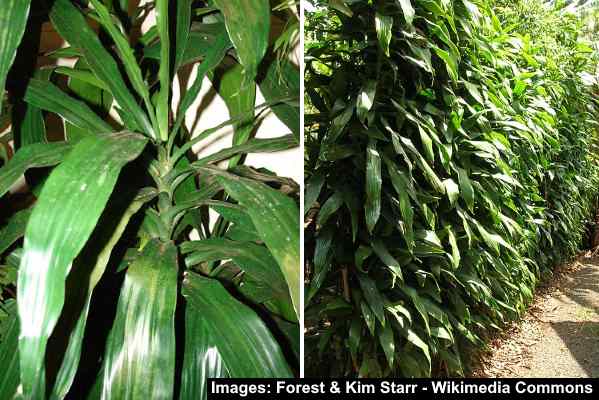
Dracaena fragrans
Dracaena fragrans, commonly known as corn plant dracaena or Dracaena deremensis, is a favored houseplant featuring broad, dark green leaves and lush bushy foliage. This versatile dracaena variety thrives in indirect light, making it an ideal choice for areas with less sunlight. With a wide array of beautiful cultivars available within the species Dracaena fragrans, you can easily find the perfect one to enhance your indoor space.
Dracaena ‘Janet Craig’ (Dracaena fragrans ‘Janet Craig’)
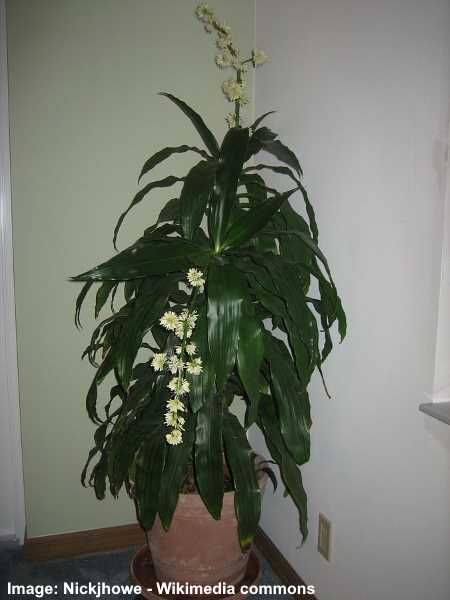
Dracaena ‘Janet Craig’ plants grow to about 3 ft. (1 m) tall indoors
The ‘Janet Craig’ dracaena plant is a shrubby flowering plant with glossy dark-green leaves. Its arching lance-shaped leaves grow up to 24 inches (60 cm) long and 3 inches (7.5 cm) wide, elegantly adorning the entire stem. As it matures, this shrubby plant can reach a height of about 2 to 4 feet (60 – 120 cm), making it an ideal choice for tabletops, desks, or as a striking floor plant to liven up corners or empty spaces.
Additionally, as the ‘Janet Craig’ dracaena matures, it sheds leaves from the lower stem, revealing a thick woody stem.
Dracaena ‘Janet Craig’ delights with clusters of fragrant white flowers blossoming on a single thick stem. As an indoor dracaena variety, it blooms indoors under optimal conditions, adding a touch of elegance to your interior green haven.
As a low-maintenance houseplant, the ‘Janet Craig’ dracaena requires minimal care and attention. It is relatively tolerant of irregular watering, making it suitable for busy individuals or those new to indoor gardening. However, it is essential to avoid overwatering, as this can lead to root rot.
To ensure its health and vitality, consider using a well-draining potting mix and avoid placing the plant in direct sunlight, which can cause leaf burn.
As with any houseplant, occasional pruning is beneficial to remove yellowing or damaged leaves.
Dracaena ‘Janet Craig’ Compacta
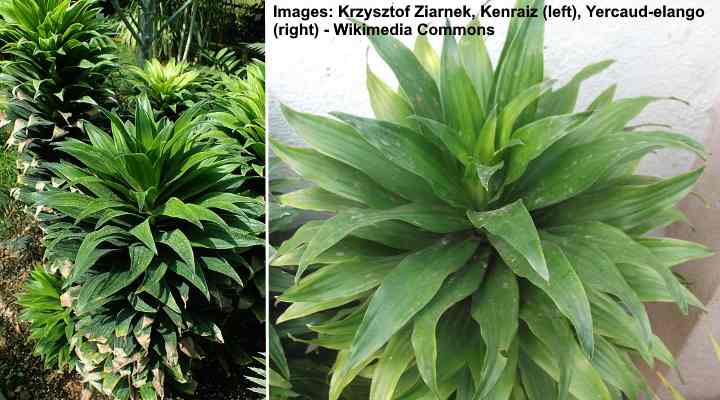
Dracaena ‘Janet Craig’ Compacta is a slow growing plant that is also called ‘Pineapple Dracaena’ and ‘Dracaena Compacta’
‘Janet Craig’ Compacta dracaena cultivar is an ideal bedroom plant as it tolerates low light. This dwarf dracaena variety has a shorter growth and smaller leaves than the larger plant.
The ‘Janet Craig’ Compacta dracaena features thick, glossy dark-green leaves that form a beautiful rosette pattern around the cane, adding a touch of elegance to your bedroom or any other indoor area. Its compact size and attractive appearance make it an excellent choice for tabletops, shelves, or corners in your living space.
Like most species of dracaena, the ‘Janet Craig’ Compacta is a slow-growing plant, making it a low-maintenance addition to your indoor space. Occasional watering is sufficient, only when the potting mixture becomes dry. Avoid overwatering, as this can lead to root rot and adversely affect the plant’s health.
To provide the best care for your ‘Janet Craig’ Compacta dracaena, use a well-draining potting mix and ensure that the plant is not exposed to direct sunlight, as this can cause leaf burn.
Lemon Lime Dracaena (Dracaena fragrans ‘Lemon Lime’)

Dracaena ‘Lemon Lime’ has variegated leaves with lime green edges and darker green and thin white stripes in the center
The ‘Lemon Lime’ dracaena is an attractive houseplant with brightly-colored yellow and green leaves, adorned with thin white stripes in between. Its elongated lanceolate leaves showcase a vibrant green band in the center, complemented by golden yellow and lime striped edges. This beautiful foliage grows in a rosette style around the central woody stem, adding a touch of elegance to your indoor space.
One of the notable features of the ‘Lemon Lime’ dracaena is its remarkable adaptability to low-light conditions. This makes it an ideal choice for brightening up any room or shaded corner, infusing your living space with a splash of vibrant colors and natural beauty.
As with many dracaena varieties, the ‘Lemon Lime’ plant is a low-maintenance companion, requiring minimal care to thrive. Its cheerful leaves and manageable growth height of 5 to 10 ft. (1.5 – 3 m) make it a versatile addition to various indoor environments.
Lemon Surprise Dracaena (Dracaena fragrans ‘Lemon Surprise’)
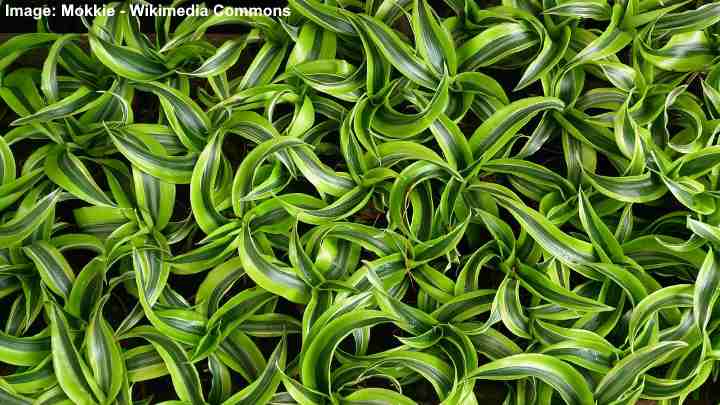
The variegated leaves of ‘Lemon Surprise’ dracaena are slightly twisted
‘Lemon Surprise’ dracaena plants have stunning variegated foliage in vibrant shades of lime green and darker green center with thin white stripes between them. The pointed leaves also have curling, twisting growth, which makes the cane plant genuinely unique.
As a cultivar of the Dracaena fragrans species, the ‘Lemon Surprise’ thrives in indirect light, making it perfect for well-lit rooms or corners with filtered sunlight. Its preference for moderate light levels allows you to place it in various locations within your home or office.
Like its dracaena relatives, the ‘Lemon Surprise’ is a low-maintenance houseplant, making it a delightful addition for both seasoned and beginner plant enthusiasts. Regularly watering the soil when it becomes dry is sufficient to keep the plant healthy, but avoid overwatering to prevent root rot.
The ‘Lemon Surprise’ can grow up to 2 to 3 feet (60 – 90 cm) in height, adding an elegant touch to any room as a floor plant. Its vibrant appearance and air-purifying qualities make it an excellent choice for brightening up bedrooms, living rooms, or even office spaces.
Warneckii Dracaena (Dracaena fragrans ‘Warneckii’)

Warneckii dracaena plant has dark green leaves with white stripes
‘Warneckii’ is one of the most popular variegated dragon plant varieties. This dracaena has long sword-shaped green leaves with wide creamy-white bands. This dracaena with white stripes is a carefree houseplant that thrives in low light or indirect bright light. Dracaena ‘Warneckii’ grows up to 2 ft. (60 cm) tall and looks like a small spiky indoor tree.
‘Warneckii’ dracaena grows well in average room temperatures of 60°F to 80°F (16°C – 27C°). You can also grow varieties of dracaena outdoors as long as the temperature doesn’t drop below 55°F (13°F).
Limelight Dracaena (Dracaena fragrans ‘Limelight’)
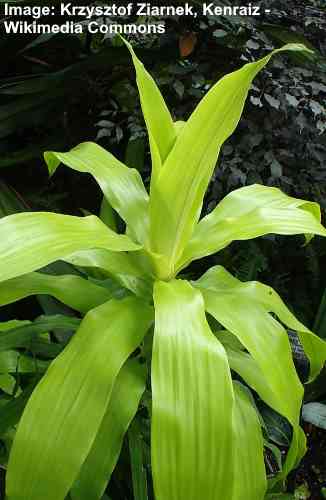
Limelight dracaena has attractive bright lime-green foliage
The attractive feature of ‘Limelight’ dracaena plants is their light electric lime-green leaves. The unusual foliage color looks almost translucent green, making this dracaena species one of the most interesting cane plants. The lime-green leaves keep their color even if the plant grows in partial to full shade.
‘Limelight’ dracaena plants grow up to 5 ft. (1.5 m) tall indoors. Make sure the potting mix is kept slightly moist, without ever becoming soggy or too damp.
Dracaena Lisa (Dracaena fragrans ‘Lisa’)
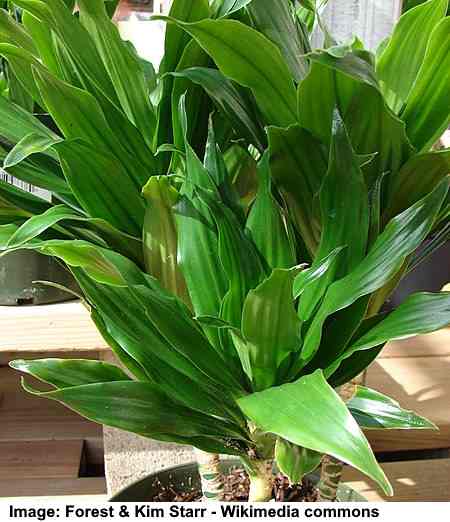
Dracaena fragrans ‘Lisa,’ also known as Lisa corn plant, is a decorative houseplant that exudes an air of graceful elegance with its stunning green and gold foliage.
The Dracaena fragrans ‘Lisa’ features long, arching leaves with a beautiful combination of dark green hues and delicate golden-yellow stripes running along the edges. This striking variegation adds a touch of sophistication to its overall appearance, making it a favorite among plant enthusiasts.
Similar to other Dracaena fragrans varieties, the ‘Lisa’ cultivar thrives in indirect light, making it well-suited for well-lit rooms or spaces with filtered sunlight. Its adaptability to different light conditions allows you to place it in various spots within your home or office.
As a low-maintenance houseplant, Dracaena fragrans ‘Lisa’ is a joy to care for, making it suitable for both experienced and novice plant owners. Regularly watering the soil when it becomes dry is sufficient to keep the plant healthy, but be cautious not to overwater, as it can lead to root rot.
With its graceful growth habit, this dracaena can reach heights of up to 4 to 6 feet (1.2 – 1.8 meters), making it an excellent floor plant that adds a touch of elegance to any room.
To ensure the well-being of your Dracaena fragrans ‘Lisa,’ use a well-draining potting mix to prevent waterlogged soil. Position the plant in a location with sufficient indirect light to maintain its vibrant colors and promote healthy growth.
Dorado Dracaena (Dracaena fragrans ‘Dorado’)
The ‘Dorado’ dracaena is a shade-loving houseplant with broad, glossy green arching leaves. The slightly variegated dracaena leaves are green with thin yellow margins. The twisting dracaena leaves aren’t as long as many others of the Dracaena fragrans cultivars.
Hawaiian Sunshine Dracaena (Dracaena fragrans ‘Hawaiian Sunshine’)
‘Hawaiian Sunshine’ dracaena plants have upright growth and are perfect for adding a visual accent to a dull corner. The glossy green striped dracaena leaves have darker green edges and a light, lime-green stripe running down the center. Although most dracaena plants are low-light houseplants, these species grow better in bright, indirect light.
Other Dracaena fragrans Cultivars
Dracaena fragrans ‘Lindenii’—The corn tree has glossy sword-like green leaves with yellow edges.
Dracaena fragrans ‘Victoria’—The ‘Victoria’ corn plant cultivar has a thick yellow band in the middle of the green leaves, similar to dracaena massangeana.
Dracaena fragrans ‘Bausei’—The dark green leaves of this corn plant have white stripes in the center.
Dracaena Massangeana (Mass Cane)
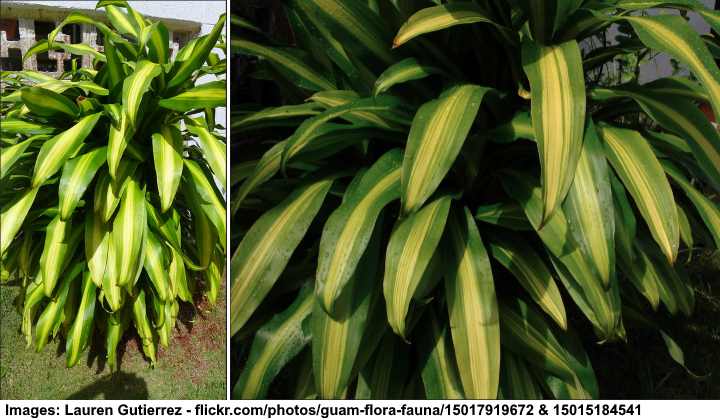
Dracaena massangeana plant prefers moderate indirect light but can also tolerate low light
Dracaena Massangeana, also known as the corn plant or cornstalk dracaena, is a favorite among dracaena varieties. It features long, arching leaves that mimic the appearance of cornstalks, earning it its nickname. The leaves display a striking combination of dark green with yellow or light green stripes down the center, adding a pop of color and enhancing any room’s décor.
What makes Dracaena Massangeana stand out is its ability to adapt to low-light conditions. This trait makes it perfect for places with limited natural light, such as offices, hallways, or dark corners needing a touch of greenery. Its tolerance for low light levels makes it a versatile and popular choice for various indoor spaces.
With its graceful growth habit, Dracaena Massangeana can reach heights of up to 6 to 10 feet (1.8 – 3 meters). This makes it an excellent floor plant, capable of creating a captivating focal point in larger living spaces.
As a low-maintenance houseplant, Dracaena Massangeana is an ideal companion for both experienced and novice plant enthusiasts. It requires minimal care to thrive, making it a hassle-free addition to your indoor garden. Regularly watering the soil when it becomes dry is sufficient to keep the plant healthy, but avoid overwatering to prevent root rot.
Dracaena Marginata (Red Edged Dracaena or Dragon Tree)
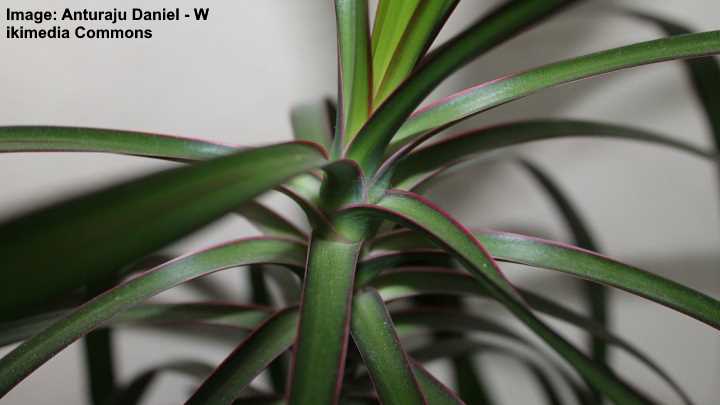
Dracaena marginata plants have green leaves with red edges
The red-edged dracaena plant (Dracaena Marginata) has spectacular thin, tapered leaves giving the dragon tree a spiky appearance. The long leaves mostly grow straight, with only the longest ones arching over. This dragon tree species has a thin upright stem that branches into separate upward-growing stems.
As the common name ‘Red-Edged’ suggests, these dracaena plants have green leaves with red edges. Other names for Dracaena marginata include pleomele, straight-marginated dracaena, Madagascar dragon tree, dragon blood tree, and red-margined dracaena. This dracaena species also has the botanical name ‘Dracaena Reflexa var. angustifolia.’
Some of the Dracaena marginata cultivars are magnificent indoor low-light houseplants. Let’s take a look at one of the best examples—Dracaena marginata ‘Tricolor.’
Dracaena Marginata ‘Tricolor’
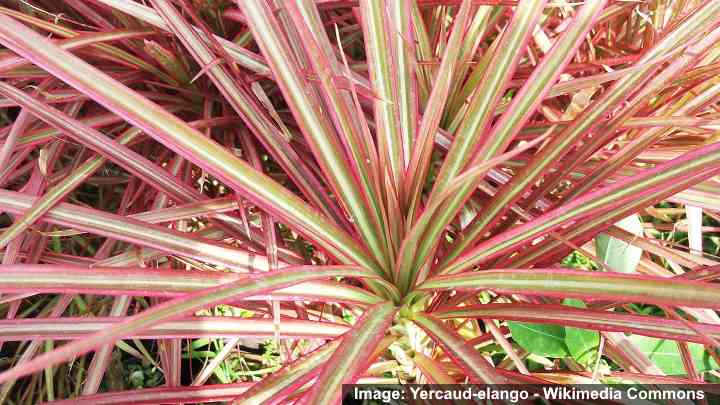
Dracaena Marginata ‘Tricolor’ has very ornamental foliage with green, cream and pinkish-red leaves
Dracaena Marginata ‘Tricolor,’ also known as rainbow plant or tricolor Madagascar dragon tree, is a stunning houseplant known for its striking tri-colored foliage. The ‘Tricolor’ dracaena has long, slender leaves with a stunning blend of green, cream, and pink hues. This unusual color combination gives the ‘Tricolor’ dracaena an overall pink appearance.
The vibrant pink edges contrast beautifully against the green and cream stripes, creating a mesmerizing visual effect. Its unique coloration and graceful growth pattern make it a show-stopping addition to any interior décor.
One of the notable features of Dracaena Marginata ‘Tricolor’ is its adaptability to different light conditions. It thrives in moderate to bright indirect light, making it suitable for various indoor environments. Its versatility allows you to place it in well-lit rooms or corners with filtered sunlight, making it a versatile choice for different spaces.
As a low-maintenance houseplant, Dracaena Marginata ‘Tricolor’ is a joy to care for, making it ideal for both experienced and novice plant owners. Regular watering when the soil becomes dry is sufficient to keep the plant healthy, but be cautious not to overwater, as it can lead to root rot.
The ‘Tricolor’ can grow up to 4 to 6 feet (1.2 – 1.8 meters) in height, making it an excellent floor plant for medium to larger indoor spaces. Its graceful and architectural appearance adds a touch of elegance to any room.
Dracaena Reflexa
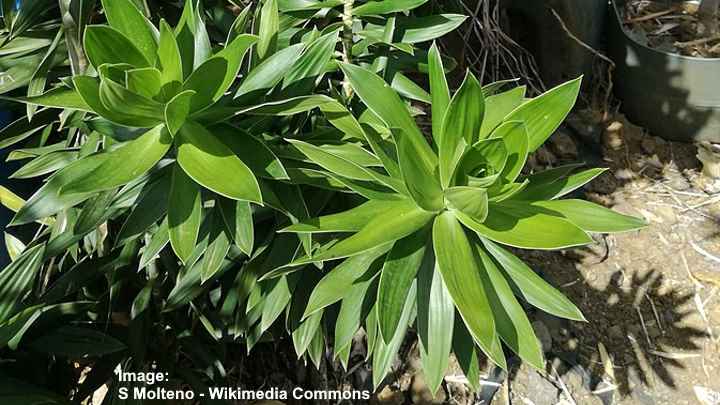
Dracaena reflexa has broad green pointed leaves
Dracaena reflexa is an ornamental plant species that has multiple stems. The dracaena is known for its broad shiny evergreen leaves, richly-colored foliage, and thick woody stems. Dracaena reflexa has an upright growth habit with glossy pointed leaves that are arranged spirally on the stems. This dracaena species is also called pleomele.
The best example of a variegated Dracaena reflexa cultivar is the ‘Song of India.’
Dracaena Song of India (Dracaena Reflexa ‘Variegata’)

Dracaena Song of India has variegated green and yellowish leaves
The Song of India dracaena is a spectacular ornamental houseplant due to its yellow-cream and green foliage. The sword-shaped variegated leaves grow in groups of three or four up the straight, upright stem. Song of India plant’s leaves have a thick green band in the center with light yellow margins.
Another feature of Song of India’s leaves is that they are reflexed—meaning that they tend to bend at 90° in the center. On the rare occasions that the dracaena flowers indoors, they will produce white aromatic flower clusters, followed by orange-red berries.
Dracaena Song of Jamaica (Dracaena Reflexa ‘Song of Jamaica’)

Dracaena Reflexa ‘Song of Jamaica,’ is a mesmerizing houseplant celebrated for its tropical charm. The ‘Song of Jamaica’ features long, graceful leaves with a delightful combination of green, yellow, and cream colors. The vibrant yellow stripes run along the edges of the lush green leaves, creating a symphony of tropical beauty. Its unique variegation and elegant growth pattern make it a captivating focal point in any interior setting.
This dracaena variety thrives in moderate to bright indirect light, making it ideal for well-lit rooms or spaces with filtered sunlight. Its adaptability to different light conditions allows you to place it in various areas within your home or office.
As a low-maintenance houseplant, Dracaena reflexa ‘Song of Jamaica’ is a pleasure to care for, making it suitable for both experienced and novice plant owners. Regular watering when the soil becomes dry is all that is required to keep the plant thriving, but be mindful of overwatering, as it can lead to root rot.
With its graceful growth habit, the ‘Song of Jamaica’ can reach heights of up to 3 to 6 feet (0.9 – 1.8 meters), making it an excellent floor plant for medium-sized indoor spaces. Its tropical allure and air-purifying qualities make it a perfect addition to any room or corner.
To ensure the well-being of your Dracaena reflexa ‘Song of Jamaica,’ use a well-draining potting mix to prevent waterlogging. Place the plant in a location with sufficient indirect light to maintain its vibrant colors and promote healthy growth.
Florida Beauty Dracaena (Dracaena Surculosa ‘Florida Beauty’)
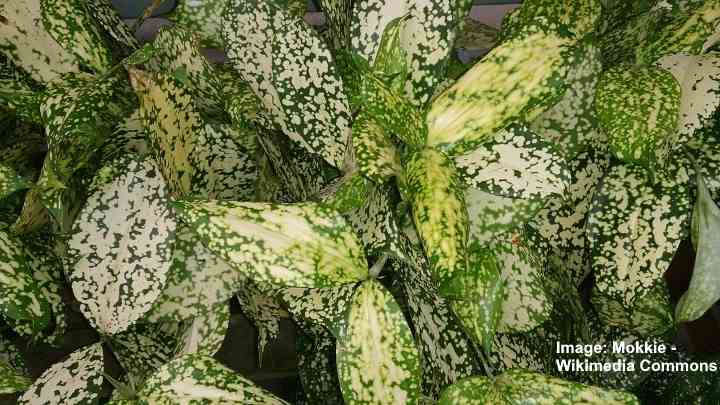
Florida Beauty dracaena has decorative variegated foliage with creamy-white blotches on the green leaves
‘Florida Beauty’ dracaena plants are an unusual species because they have rounded leaves rather than sword-shaped ones. The fascinating feature of ‘Florida Beauty’ dracaenas is their variegated foliage. The green leaves have splashes of creamy-white splotches. These oval leaves have a pronounced point at their tips.
Dracaena surculosa ‘Florida Beauty’ is a multi-stemmed type of dracaena plant with several upright woody stems. This dracaena species is also known as gold dust, spotted dracaena, and gold dust dracaena.
Prune this dracaena species to remove dead or dying foliage to improve the plant’s appearance.
Lucky Bamboo (Dracaena Sanderiana)
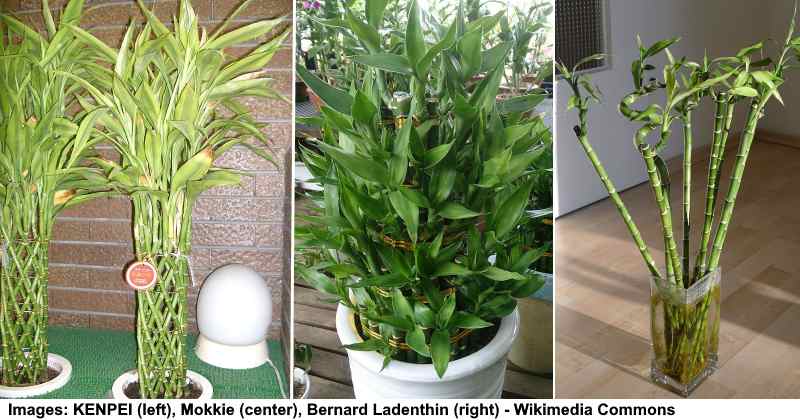
Examples of dracaena sanderiana plants
Lucky bamboo is a type of dracaena plant with thick light green stems and lanceolate foliage. These cane-like stalks are often sold with curled tops and a few leaves growing from them. The hardy lucky bamboo plants grow in soilless mixes or even in water.
Lucky bamboo is a popular indoor plant in Asia where it’s said to bring good luck. Despite its common name, this plant isn’t a member of the bamboo species. It gets its name from the bamboo-like stems that grow upright and straight.
Other names for the Dracaena sanderiana include curly bamboo, Chinese water bamboo, Belgian evergreen, ribbon plant, and Sander’s dracaena.
Dracaena Arborea
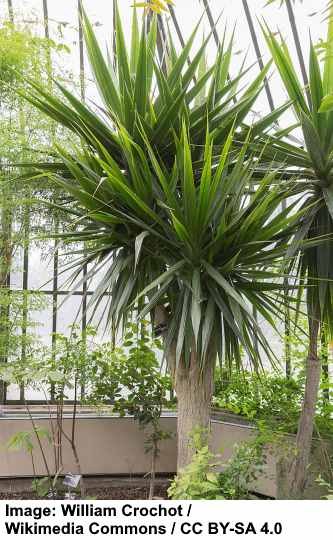
Dracaena arborea can reach 10-15 ft. (3 – 4.5 m) tall
Dracaena arborea, also known as the slender dragon Tree, is a majestic and impressive houseplant that resembles a miniature tree. Its striking appearance and unique growth pattern make it a captivating addition to any indoor space.
The Dracaena arborea features a thick, woody trunk with lush, arching leaves that radiate from the top, resembling a small tree canopy. The leaves are long, narrow, and beautifully green, adding a touch of elegance to its overall look. Most of these dragon trees branch out with two or more branches. The long slender lance-shaped leaves grow straight to create a rounded, spiked crown. Its tree-like structure makes it a remarkable focal point in any room or living area.
This variety of dracaena thrives in moderate to bright indirect light, making it ideal for well-lit rooms or spaces with filtered sunlight. Its preference for moderate light levels makes it suitable for various indoor environments, allowing you to position it according to your space and lighting conditions.
As a low-maintenance houseplant, Dracaena arborea is relatively easy to care for, making it suitable for plant enthusiasts of all levels. Regular watering when the soil becomes dry is sufficient to keep the plant healthy, but be cautious not to overwater, as it can lead to root rot.
With its graceful growth habit, Dracaena arborea can grow up to 4 to 6 feet (1.2 – 1.8 meters) in height, depending on the conditions. Its tree-like structure and air-purifying qualities make it an excellent choice for larger indoor spaces or as a statement piece in any room.
To ensure the well-being of your Dracaena arborea, use a well-draining potting mix to prevent waterlogged soil. Position the plant in a spot with adequate indirect light to maintain its vibrant green color and promote healthy growth.
Dracaena Trifasciata
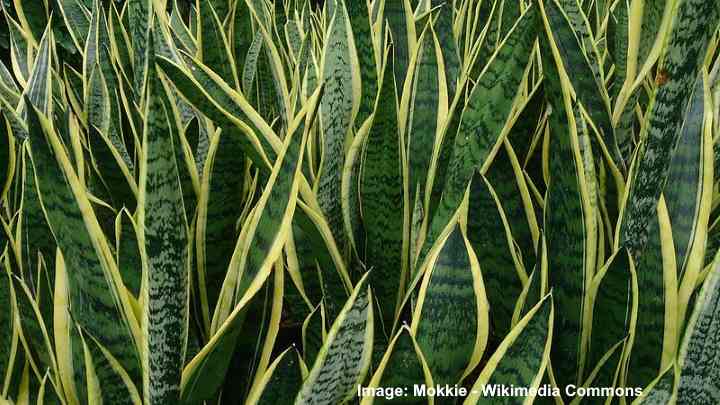
Dracaena trifasciata are known as ‘snake plants’ in the genus Sansevieria which was changed to Dracaena on 2017
Dracaena trifasciata, commonly known as the snake plant or mother-in-law’s tongue, is a striking and hardy houseplant admired for its unique appearance and air-purifying qualities.
The Dracaena trifasciata features long, upright leaves with distinctive dark green coloration, accentuated by light green bands or stripes that resemble the patterns of a snake. This variegation adds a touch of intrigue to its sleek and modern look, making it a popular choice for contemporary indoor spaces.
One of the remarkable qualities of Dracaena trifasciata is its ability to thrive in various light conditions. It can tolerate low light or bright indirect light, making it an excellent choice for spaces with limited natural sunlight or even corners away from windows.
As a low-maintenance houseplant, the snake plant is perfect for busy individuals or those new to plant care. It requires minimal watering and can withstand periods of neglect, making it a resilient and forgiving addition to any indoor garden.
With its compact and upright growth habit, the snake plant typically reaches heights of 2 to 4 feet (0.6 – 1.2 meters), making it an ideal floor or tabletop plant. Its adaptability to different light levels and its air-purifying capabilities make it a fantastic choice for bedrooms, living rooms, or even offices.
To ensure the well-being of your Dracaena trifasciata, use a well-draining potting mix to prevent waterlogged soil. Allow the soil to dry between waterings, as the snake plant is sensitive to overwatering, which may cause root rot.
Dracaena surculosa ‘Milky Way’
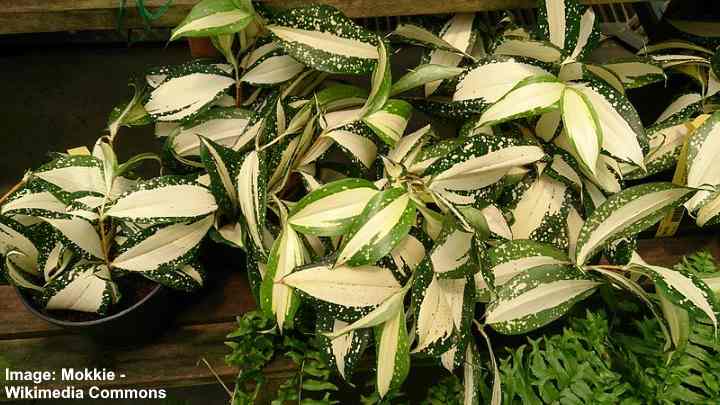
The rare Dracaena surculosa ‘Milky Way’ has stunning foliage with white and green elongated leaves
One of the most exotic and visually striking varieties in the Dracaena family is the Dracaena surculosa ‘Milky Way’. This rare cultivar is celebrated for its unique foliage and distinctive growth pattern. The ‘Milky Way’ exhibits a clumping growth habit, characterized by slender, arching stems that support broad, elliptical leaves. Each leaf features a pattern of white specks and streaks against a dark green backdrop, reminiscent of a starry night sky, which inspires the name ‘Milky Way’.
At the center of each leaf is a long, white band that further enhances its celestial resemblance and lends this variety its distinctive name. With its compact stature, reaching only about 1 foot (30 cm) in height, it serves as an ideal addition to any indoor plant collection, especially suitable for spaces where room is at a premium.
Dracaena marginata ‘Magenta’
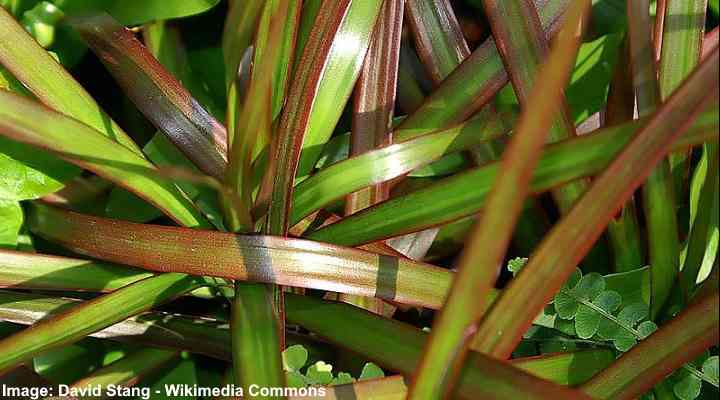
The long and narrow leaves of Dracaena marginata ‘Magenta’ are green with reddish edges
The Dracaena marginata ‘Magenta’ is distinguished by its slender, arching green leaves with vibrant magenta-red edges, resembling a palm tree in form.
Native to areas where it can reach heights of 15 to 20 feet (4.5 – 6 m), this variety is easily maintained at a manageable height of 6 feet (1.8 m) or less as a houseplant.
Thriving in bright indirect or filtered sunlight, the ‘Magenta’ combines the ease of care with striking foliage, making it an ideal choice for adding a touch of color and vertical interest to indoor spaces.
Dragon Tree ‘Colorama’ (Dracaena marginata ‘Colorama’)
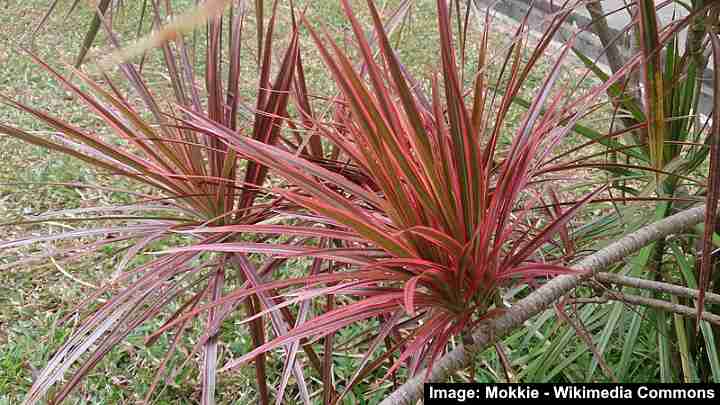
The dragon tree ‘Colorama’ has stunning foliage that adds a focal point to any space
The dragon tree ‘Colorama’ (Dracaena marginata ‘Colorama’) captivates with its variegated foliage, showcasing a vivid display of pink, accented with white and green stripes.
To maintain its distinctive coloration, it requires bright yet indirect light. Ideal for indoor settings, the ‘Colorama’ reaches a height of 5-6 feet (1.5 – 1.8 m), offering a striking vertical element to any space without overwhelming it.
Its preference for filtered sunlight makes it a versatile addition, thriving in conditions that mimic the dappled light of its native habitat.
The Most Popular Types of Dracaena
The most popular types of dracaena plants are the Dracaena deremensis ‘Janet Craig,’ with its long, broad green leaves, the ‘Warneckii’ dracaena with spiky-looking variegated green and cream-colored leaves, the red-edged Dracaena marginata with red and green leaves, and the Dracaena reflexa ‘Song of India’ with its pointed yellow and green leaves.
Another popular species of dracaena is Dracaena sanderiana or lucky bamboo. Although this plant looks like bamboo, it’s a member of the genus Dracaena. The auspicious plant often has a distinctive curly top with a few leaves. This plant grows well in water without any soil.
Care Guide for Growing Dracaena Species
All varieties of Dracaena plants are renowned for their ease of care, making them a perfect choice for adding lush, leafy greenery to indoor spaces. With proper care, these plants can flourish for many years, enhancing your home décor with their vibrant foliage.
Dracaena Light Requirements
Dracaena plants are quite adaptable and can thrive in a range of light conditions. They prefer bright, indirect light but are also capable of growing in lower light settings. Avoid exposing them to direct sunlight, which can scorch their leaves. These plants are well-suited for indoor environments like offices, bedrooms, bathrooms, and areas facing north where light is more diffused.
Dracaena Soil
The health of Dracaena plants starts with the right soil mix. A loose, well-aerated, and nutrient-rich potting mix is crucial for their growth. A recommended blend consists of one part peat moss, one part houseplant soil, and one part perlite. This combination ensures the soil retains enough moisture and nutrients while providing excellent drainage, preventing water from pooling at the roots.
Dracaena Watering Needs
Watering is a critical aspect of Dracaena care. These plants prefer the soil to dry out partially between watering sessions. Check the top half of the soil for dryness, and water thoroughly, allowing excess water to drain away. This method helps prevent overwatering and root rot, common issues that can adversely affect the plant’s health. Remember, Dracaena’s watering needs may decrease during the winter months.
Dracaena Temperature and Humidity
Dracaena plants enjoy the warmth and do best in average room temperatures ranging from 60°F to 80°F (15°C to 27°C). They are not particularly demanding regarding humidity and can thrive in the average humidity levels found in most homes. However, in very dry climates or during the winter when indoor heating can lower humidity levels, consider using a humidifier or placing a water tray near the plant to increase moisture in the air. Despite their adaptability, protect them from drafts and sudden temperature changes to avoid stress. Outdoors, Dracaena can be grown in USDA zones 10 and 11, where temperatures are consistently warm.
Fertilization
Feed your Dracaena plant with a balanced, liquid houseplant fertilizer every 6 weeks during the spring and summer to support its growth. Reduce feeding in the fall and winter when the plant’s growth naturally slows down.
Cleaning and Maintenance
Dust can accumulate on Dracaena’s broad leaves, hindering photosynthesis and growth. Wipe the leaves gently with a damp cloth or sponge to keep them clean and healthy. This also helps in inspecting the plant for signs of pests or diseases.
Repotting
Dracaena plants typically need to be repotted every 2-3 years or when they become root-bound. When repotting, choose a pot that is slightly larger than the current one to give the roots room to grow. Use fresh potting mix and ensure the new pot has adequate drainage holes.
Dracaena Plants – FAQ
How often should I water my Dracaena plant?
Water your Dracaena when the top 50% of the soil is dry. This typically means every 1-2 weeks, but adjust based on your home’s humidity and temperature.
Why are the tips of my Dracaena’s leaves turning brown?
Brown tips can result from low humidity, overwatering, or fluoride in tap water. Try increasing humidity, ensuring the soil dries out between waterings, and using filtered water.
How much light does a Dracaena need?
Dracaena plants prefer bright, indirect light but can tolerate lower light conditions. Avoid direct sunlight to prevent leaf burn.
Is Dracaena toxic to pets?
Yes, Dracaena plants are toxic to cats and dogs if ingested. The plant contains saponins, which can cause vomiting, drooling, and weakness in pets. Keep these plants out of reach of your furry friends.
How do I propagate a Dracaena plant?
Dracaena can be propagated from stem cuttings. Cut a 4-6 inch piece of stem, let it dry for a couple of days, then plant it in soil. Keep the soil moist and in indirect light until new growth appears.
How can I tell if I’m overwatering my Dracaena?
Signs of overwatering include yellowing leaves, soft and mushy stems, or drooping leaves. Let the soil dry out more between waterings, and ensure your pot has good drainage.
Related articles:
- Types of Snake Plants with Care Tips
- Indoor Plants That Don’t Need Sunlight
- Best Tall Houseplants for Homes and Offices
